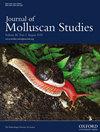Development of Lacuna pallidula (da Costa, 1778) from the White Sea (Caenogastropoda: Littorinimorpha) with emphasis on radula formation
IF 1.2
4区 生物学
Q2 MARINE & FRESHWATER BIOLOGY
引用次数: 0
Abstract
The gastropod radula is highly diverse in structure in comparison with that of other mollusсs. The main radular types in the different phylogenetic groups of gastropods differ not only in the general morphology and configuration of the teeth but also in the mode of tooth synthesis and the ultrastructure of the formation zone. Previously, the formation and anlage of the radula in the ontogeny of radulae of all major phylogenetic gastropods groups have been studied, with the exception of the taenioglossan radula of Caenogastropoda. The data obtained in this study on the radular anlage and synthesis in one littorinimorph species Lacuna pallidula supplement the existing knowledge of diversity in gastropod radula formation. The radula is initially formed at the stage of the post-torsion veliger, with five teeth in each transverse row, and acquires the adult morphology before hatching from the egg mass. The larval radula is synthesized by a few morphologically uniform cells in the radular sac. Synthesis of the adult radula also occurs at the blind end of the radular sac, where groups of numerous odontoblasts each form one tooth, and membranoblasts, located on the ventral side, form the membrane. Characteristic features of the adult radular sac are an additional supporting cartilage-like structure at the radula curve in the middle of the radular sac, a well-defined proliferation zone in the zone of radula formation and the presence of an additional extracellular matrix around the teeth in the maturation zone.白海苍白拉库纳(da Costa,1778)的发育(Caeno腹足目:Littorinimorpha),重点是拉库纳的形成
与其他软体动物相比,腹足动物的结构高度多样化。腹足类动物不同系统发育类群的主要根瘤类型不仅在牙齿的一般形态和构型上存在差异,而且在牙齿的合成方式和形成带的超微结构上也存在差异。在此之前,除了Caenogastropoda的taenioglossan radula外,所有主要的腹足类动物的系统发育类群的radula的形成和分析都被研究过。本研究获得的一种垂生小变形物种Lacuna pallidula的放射状标本和合成数据补充了现有的腹足动物放射状形成多样性的知识。齿槽最初形成于扭后齿槽阶段,每横排有5颗齿,从卵群中孵化前就已具备成虫形态。幼虫的腺孔是由腺囊内几个形态一致的细胞合成的。成人牙髓的合成也发生在牙髓囊的盲端,在那里,大量成牙细胞形成一颗牙齿,位于腹侧的成膜细胞形成膜。成人结节囊的特征是在结节囊中间的结节曲线处有一个额外的支撑软骨样结构,在结节形成区有一个明确的增殖区,在成熟区牙齿周围有一个额外的细胞外基质。
本文章由计算机程序翻译,如有差异,请以英文原文为准。
求助全文
约1分钟内获得全文
求助全文
来源期刊

Journal of Molluscan Studies
生物-动物学
CiteScore
3.00
自引率
8.30%
发文量
36
审稿时长
3 months
期刊介绍:
The Journal of Molluscan Studies accepts papers on all aspects of the study of molluscs. These include systematics, molecular genetics, palaeontology, ecology, evolution, and physiology. Where the topic is in a specialized field (e.g. parasitology, neurobiology, biochemistry, molecular biology), submissions will still be accepted as long as the mollusc is the principal focus of the study, and not incidental or simply a convenient experimental animal. Papers with a focus on fisheries biology, aquaculture, and control of molluscan pests will be accepted only if they include significant advances in molluscan biology. While systematic papers are encouraged, descriptions of single new taxa will only be considered if they include some ‘added value’, for example in the form of new information on anatomy or distribution, or if they are presented in the context of a systematic revision or phylogenetic analysis of the group.
 求助内容:
求助内容: 应助结果提醒方式:
应助结果提醒方式:


